
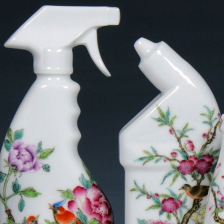
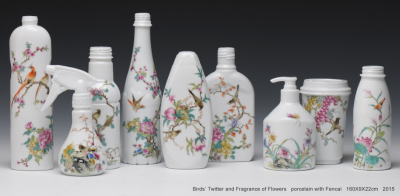
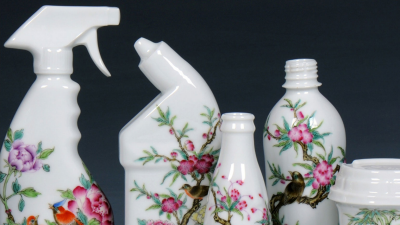
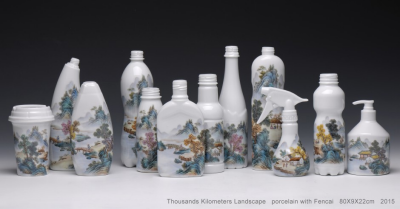
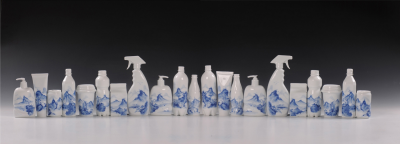

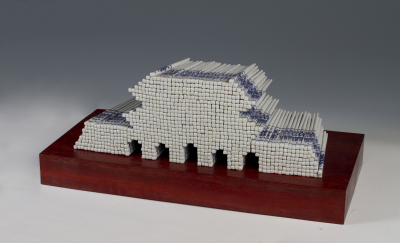
The works of Chinese artist Wan Liya offer many paradoxes,
and there is far more here than meets the eye.
중국 아티스트인 리야 완의 작업들은 예쁘기만 한 작업이 아닌, 많은 역설을 표현한다.
Born in QingDao, China in 1960’s, Wan is a product of eastern thought, Zen principles,
and Buddhist philosophies, and yet, his paintings exhibit many aspects
founded in 20th century western art.
1960년대 중국 칭다오에서 태어난 완은 동양적 사고방식, 선종의 원리, 그리고 불교 철학의 산물이다.
하지만 그의 회화는 20세기 서양미술에서 찾아볼 수 있는 다양한 면면들을 표현한다.
His paintings are imbued with rich primary colors, creating moods and sensations.
그의 회화는 풍부한 원색으로 가득차 분위기와 감각을 만들어낸다.
The American color field artists, like Mark Rothko and Helen Frankenthaler,
elicited similar emotional response through color, but by very different means.
Unlike Frankenthaler’s use of diluted color pigments poured onto unprimed canvasses,
Wan’s work’s are structured through texture, as well as color and pattern.
마크로스코나 헬렌 프랑켄탈러같은 미국 색면추상 작가들은
색을 통해 비슷한 감정적 반응을 이끌어내지만 아주 다른 수단을 사용한다.
표면 처리가 되지 않은 캔버스에 부은듯한 프랑켄탈러의 희미한 색의 사용과는 다르게,
완의 작업은 텍스쳐, 색, 그리고 패턴을 통해 이루어진다.
The methodologies are almost opposite; the effects very similar.
현상들은 매우 비슷하나, 방법론적인 부분은 거의 반대된다.
Wan is perhaps more aligned with “action” painting because he manipulates the canvas itself,
and allows the paint to find its own place, its own texture, its own pattern,
and its own blended colors.
완은 캔버스 그 자체를 조절하고, 페인트가 자기 자리, 텍스쳐, 패턴,
그리고 색을 찾을 때까지 놔둔다는 점에서, 아마 ‘액션’ 페인팅에 더 가까울 것이다.
Wan would say he is an instrument, applying the paint, folding the canvas
in patterns and the final product is the result of the laws of nature.
완은 그 자신을 도구라고 말한다. 페인트를 바를 때에, 패턴의 모양대로 캔버스를 접을 때,
그리고 마지막 완성작이 자연의 섭리에 따른 결과라고 말한다.
Patterns and colors emerge from an incidental process.
패턴과 색은 우연적인 과정에서 생겨난다.
The final painting is a vision ultimately created by chance, by nature,
by expectations that can never be exact or known.
완성된 작품은 궁극적으로 우연에서, 자연적으로, 절대로 정확하거나 알 수 없는 세계를 보여준다.
The possible outcome and combinations in each and every painting are literally infinite.
각각의 모든 그림들의 가능한 결과와 조합물은 무한대라고 말할 수 있다.
Wan’s work can bring to mind the multi-layered, scraped surfaces
with blended paint coloration, texture and pattern found in Gerhardt Richter’s work,
an artist Wan greatly admires.
완의 작업은 게르하르트 리히터의 작업에서 찾아볼 수 있듯,
여러 겹의, 긁어진 표면과 섞인 페인트 배색, 텍스쳐와 패턴에 신경을 쓰고,
이는 완이 작가로서 매우 선망하는 것이다.
Although the methods of the two artists are totally different,
the visual outcome has similarities.
비록 두 명의 작가들의 방법이 매우 다르지만, 시각적인 결과물에서는 비슷한 점들이 있다.
Both artist’s works evoke transcendent emotional states much like Rothko achieved
60 years ago, but through very different means.
두 명의 작가의 작업들은 로스코가 60년 전에 얻은 것과 같은
초월적인 감정적 상태를 불러일으키지만, 매우 다른 방법으로 그러하다.
In these works, the common thread is this :
the subject matter is the subjective experience of color itself, nothing else.
이 작업들에서 공통점은 이것이다 : 주제 내용는 색 자체에 대한 주관적인 경험이고 다른 것이 아니다.
So in the end, Wan is a combination of east and west, a global artist.
결과적으로, 완은 동양과 서양의 조합이며, 세계적인 작가이다.
In his work he uses his own intuition, his own impulse, deciding
what colors to apply and where to apply them on the canvas.
그의 작업에서 그는 그만의 직관, 충동을 이용해 어떤 색을 캔버스의 어디에 바를지 결정한다.
Then he manipulates the canvases ,
folding in various patterns, interacting with the canvas support.
그리고 그는 다양한 패턴으로 접고, 캔버스의 힘을 받는 부분들을
서로 상호작용하게 하며 캔버스를 조정한다.
But then he relies on Nature to produce the final stroke, to complete the human process.
하지만 그는 마지막 한 획을 만들어 인간의 과정을 완성하는 데는 자연에 의존한다.
He sees the process as man and nature working together.
그는 작업과정을 사람과 자연이 함께 일하는 것으로 본다.
The outcome is very beautiful symphony of color, texture and pattern,
made by nature , as well as by man.
결과물은 자연과 사람이 만들어낸 색채, 텍스쳐와 패턴의 아름다운 교향곡이다.
Hollis C. Taggart
홀리스 C. 타가트
Owner of Hollis C. Taggart Galleries in New York
뉴욕 홀리스 C. 타가트 갤러리 소유자